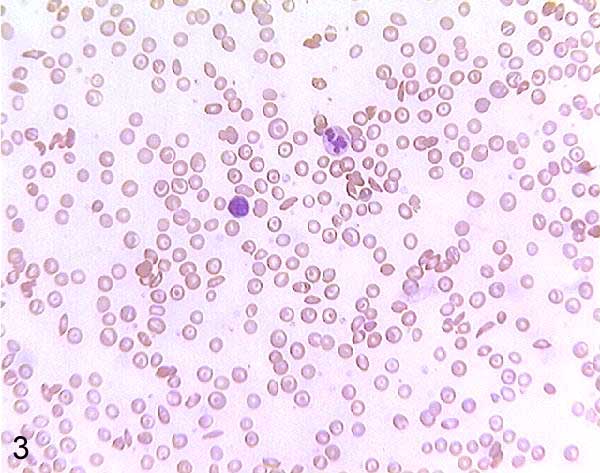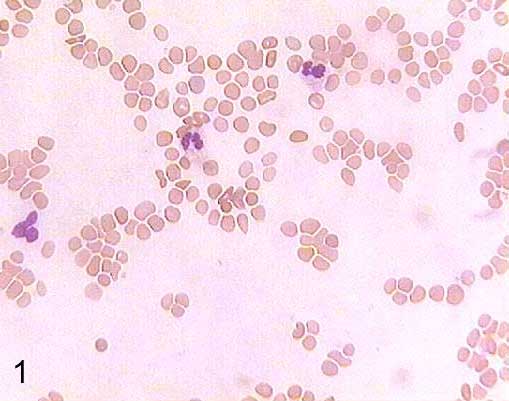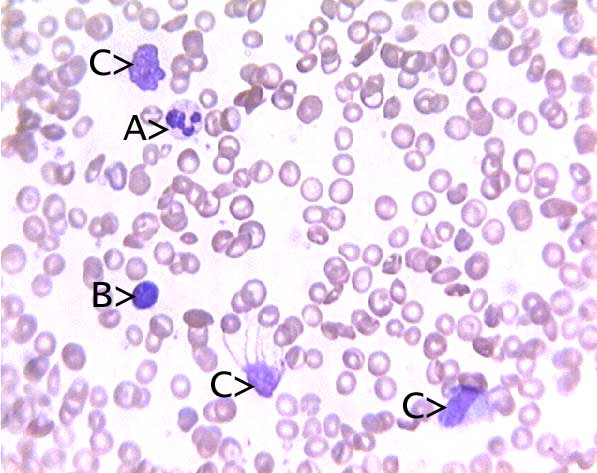Looking at blood smears
Interpreting blood smears is a specialized art. This page will not
instill that art (much blood work is now done by machine, anyway) but rather
provides only an initial introduction.
You may skip over the instruction on this page and go directly
to sample blood smears.
The phrase "blood smear" is descriptive of how the preparation
is made. A drop of blood is placed on the slide, smeared across it,
fixed, dried, stained (commonly with Wright's stain; the name commemorates
James Homer Wright, b. 1869), and covered.
One can make smears not only of
peripheral blood (circulating blood, taken from a vein) but also of bone marrow
(where blood is formed) or of inflammatory infiltrate (pus).
When examining a blood smear, such as a slide from your reference collection, you should focus attention on suitable
areas. The best region is typically toward the center of the smear,
away from the edges.
(The following images were taken from a specimen from a
sickle-cell patient. Due to inexpert image processing, color may vary
from image to image.)
 When
viewing a blood smear, notice first the numerous red
blood cells, pale cells without nuclei. Do not concentrate on individual
cells, but scan over a large population of cells. Pay attention to the
following features.
When
viewing a blood smear, notice first the numerous red
blood cells, pale cells without nuclei. Do not concentrate on individual
cells, but scan over a large population of cells. Pay attention to the
following features.
Typical cell size. Quantitative estimation requires special
tools.
Variation in cell size. Are all cells nearly the same? Are
many cells noticably bigger, or smaller, than the typical cell? Are
there cells in both bigger and smaller categories?
Variation in cell shape. Do many cells appear in any
shape that is dramatically different from round, such as pointy?
Variation in cell texture. Do all cells stain similarly pink,
or do some contain basophilic patches or granules? (Recently-formed
RBCs may retain bits of immature cytoplasm. The proportion of such
cells is indicative of the rate at which RBCs are being produced.)
 Next
scan for white blood cells. These are
larger than RBCs, with prominent blue (stained) nuclei. List by type
each example as it is seen. By the time you have counted a hundred or
so, you should have a fair estimate of the proportion of the commonest types.
Next
scan for white blood cells. These are
larger than RBCs, with prominent blue (stained) nuclei. List by type
each example as it is seen. By the time you have counted a hundred or
so, you should have a fair estimate of the proportion of the commonest types.
 In
normal blood, a majority will be neutrophils
and most of the remainder will be lymphocytes.
These two types are easy to learn, because they are so common and because
they look so different from one another.
In
normal blood, a majority will be neutrophils
and most of the remainder will be lymphocytes.
These two types are easy to learn, because they are so common and because
they look so different from one another.
 Monocytes,
eosinophils and basophils
are a bit harder, partly because several hundred leukocytes (in a normal
smear) must be examined to find and estimate these cell populations and
partly because the range of appearance for these cells (especially monocytes)
overlaps that for neutrophils and basophils.
Monocytes,
eosinophils and basophils
are a bit harder, partly because several hundred leukocytes (in a normal
smear) must be examined to find and estimate these cell populations and
partly because the range of appearance for these cells (especially monocytes)
overlaps that for neutrophils and basophils.
 Platelets
are tiny (much smaller than RBCs) flecks of granular cytoplasm, often appearing
in clumps.
Platelets
are tiny (much smaller than RBCs) flecks of granular cytoplasm, often appearing
in clumps.
A thorough blood smear examination includes not only the characteristics
and proportions of mature cells but also the proportion of each type which
appears immature.
Each blood cell type has several named maturational stages. Although
most blood cell maturation occurs in bone marrow where the cells form, some
immature forms also appear in peripheral blood.
A red cell which contains basophilic strands or granules (remnants of cytoplasm
not yet completely replaced by hemoglobin) is called a reticulocyte.
Neutrophils are commonly identified as "bands" (immature,
with a band-shaped nucleus) and "segs" (mature, with a
nucleus segmented into distinct lobes).
Below is an example from a sickle-cell patient. Note variation in RBC
size and shape. A key to the WBCs is below the image.
This micrograph does NOT represent an ideal sample from the patient's blood.
Rather, it has been chosen to show how white blood cells can appear
when artefactually damaged during preparation. Such unclassifiable
blobs are not uncommon in ordinary blood smears.
A. Neutrophil, segmented.
B. Lymphocyte.
C. Remains of damaged cells, to be ignored.
Click here to view some sample
blood smears.
For more information about blood cell types, including more images, see Blood
cells. For more general information, return to Introduction
to blood.
 Also avoid areas
which resemble Figure 2, where the blood cells are jumbled together
and touching one another.
Also avoid areas
which resemble Figure 2, where the blood cells are jumbled together
and touching one another.  Concentrate your
examination in areas where the cells are individually separated from one
another and fairly uniformly dispersed, as in Figure 3.
Concentrate your
examination in areas where the cells are individually separated from one
another and fairly uniformly dispersed, as in Figure 3.
 Avoid areas that
resemble Figure 1, in which the blood cells are clumped or unevenly
dispersed.
Avoid areas that
resemble Figure 1, in which the blood cells are clumped or unevenly
dispersed.  When
viewing a blood smear, notice first the numerous
When
viewing a blood smear, notice first the numerous  Next
scan for
Next
scan for  In
normal blood, a majority will be
In
normal blood, a majority will be 
 Platelets
are tiny (much smaller than RBCs) flecks of granular cytoplasm, often appearing
in clumps.
Platelets
are tiny (much smaller than RBCs) flecks of granular cytoplasm, often appearing
in clumps. 